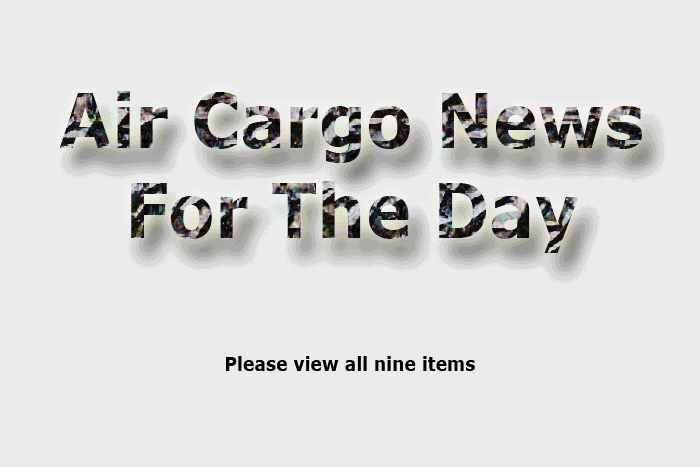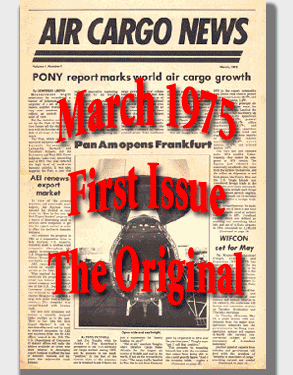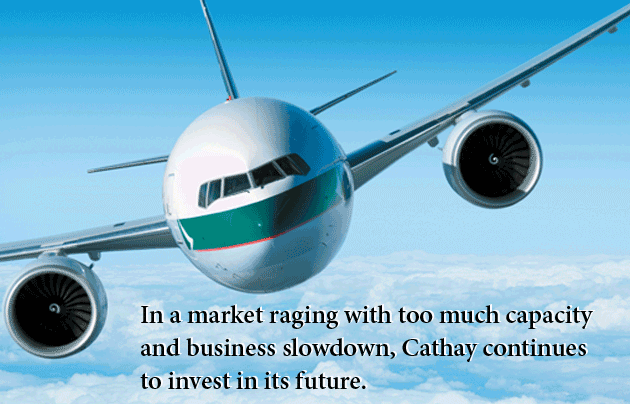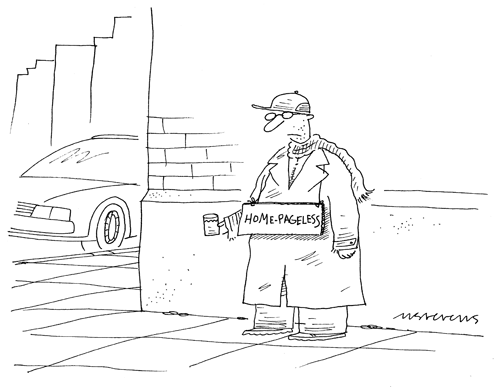

 o convention or single gathering of air cargo executives goes by without
someone stepping forward and demanding better cooperation amongst the
stakeholders involved—airlines, forwarders, 3PL logistics providers,
and shippers.
o convention or single gathering of air cargo executives goes by without
someone stepping forward and demanding better cooperation amongst the
stakeholders involved—airlines, forwarders, 3PL logistics providers,
and shippers.
Shippers in particular are quick to point out that they do not feel
“recognized” by operators, and forwarders are bemoaning
that airlines task them with collecting surcharges (fuel and security)
but that they’re not compensated for such efforts.
The truth, probably, is in the middle,
but it seems that the parties involved know too little about each other’s
modus operandi to make an informed judgment.

A factor contributing to the challenge
of collecting surcharges is that often this task is carried out by staff
that do not have the required background knowledge and training to get
these things right.
First complaint brought up by shippers:
‘(Legacy) Airlines do not offer the product we need and want.’
There is a reason why the business is
split between airlines and forwarders, typically involving the services
of both.
Then of course there are the services
of integrators such as UPS, FedEx, and TNT who “integrate”
into one, both the services typically covered by the forwarder and the
services typically provided by the airline.

Being in the airline business involves
huge investments into aircraft, MRO, organization, and contracting (or
carrying out in-house) a multitude of services, IT, and infrastructure.
Not the least challenging part is to comply
with complex regulatory requirements in all states in which one does
business, or even merely lands aircraft.
Forwarders, and in particular 3PL logistics
providers, may or may not face similar investments.
The contemporary way of being a logistics
provider does not necessarily require owning warehouse space or a fleet;
everything can be subcontracted, and sometimes is.
Most of us are undoubtedly familiar with
the concept of “ad hoc – rates.”
A forwarder (sometimes also a shipper,
then called a “direct shipper”) has a larger consignment
of cargo and would like to have a special discounted rate for this consignment.
Sometimes because it’s too bulky, sometimes because it’s
nice and dense, sometimes because the shipper says that they’re
not willing to pay more than amount X.
This can also make sense for the airline;
for example, flights for which demand is weak will likely receive a
bigger discount than a weekend freighter to a popular destination.
However, there is a reason why the airfreight
business traditionally involves shippers, forwarders, and airlines (and,
of course, also the Ground Handling provider who carries out certain
services for the airline).

 Joost
van Doesburg, air freight policy manager at the European Shippers’
Council (ESC), stepped forward recently to fight changes in surcharges
proposed by players such as Korean Air Cargo, Lufthansa Cargo, and Emirates
Sky Cargo. Joost
van Doesburg, air freight policy manager at the European Shippers’
Council (ESC), stepped forward recently to fight changes in surcharges
proposed by players such as Korean Air Cargo, Lufthansa Cargo, and Emirates
Sky Cargo.
Mr. Van Doesburg seems to have an incomplete
grasp of the rules and requirements applicable to air transport.

A forwarder provides service dealing with
the multifold challenges relating to export, import, and safe transportation
of merchandise, something beyond the abilities of most shippers’
logistics departments.
The airline provides a quick and reliable
means of long distance transport.
There hasn’t been a year in recent
history without an airline going bankrupt, out of business, restructuring
or cutting back the organization. That however, has not been a common
occurrence in the forwarder or the shipper industry.
So it seems that while two of the traditional
three stakeholders usually make money, the latter is not true for the
airlines, at least not the traditional legacy type of airline.

While Mr. van Doesburg points out that
the shipper’s trust in the airlines is at a low point, referring
to the cartel lawsuits, one must point out that the same goes for the
forwarders, something Mr. van Doesburg forgot to mention now; he mentioned
it about a year ago, during a price fix dust up involving some larger
forwarders. At that time he advised shippers in a published interview,
in the now defunct IFW:
"From my perspective, the most ideal
situation would be for shippers to book cargo at an airline," said
van Doesburg.

A large part of our everyday apparel is
manufactured in Asia and a majority of apparel is shipped by sea, but
high-priced garments (or those where there are production delays or
unexpected demand) are flown in by airfreight – mostly in the
form of so-called “hanging garments” in ULDs.
Often neither the shipper nor the consignee
of these containers (which are intended to go from the manufacturers’
warehouse to the delivery warehouse) can carry out their handling in
compliance with the applicable requirements, as the ULD’s are
not equipped to be handled by forklifts and may only be loaded and unloaded
by means of slave pallets or rollerlanes and transported on rollerbed-equipped
trucks.

The IATA ULD Regulations (and the IATA
Airport Handling Manual) contain very specific requirements applicable
to any party handling ULD’s. In practice, forwarders, shippers
and consignees do not have the equipment in place or the required training,
and the necessary requirements are seldom enforced by airlines for fear
or losing business.
Aircraft containers aim at maximizing
the cargo load aboard a plane and for this reason are shaped in accordance
with the aircraft’s contour.
As example four AKE (LD3) containers with
hanging garments destined from HGK to FMO, is not really good business
for the airline.
Even if the airline has flights directly
into a secondary airport such as FMO, chances are that such a flight
is not operated with widebody aircraft capable of carrying LD3-type
containers, so the airline will have to pay a whole truck to transport
four LD3 type containers with a possible total chargeable weight of
1,200 kg from another German arrival airport to FMO.
Since the containers will also need to
be returned the airline will have to pay a second truck to pick them
up.
GHA’s and airlines also have to
deal with cargo unfit for carriage.
Since shippers know little about the way
airlines conduct business, especially in the shipping of outsized machinery,
they often forget to clearly indicate that certain pieces can only be
handled by crane and not by forklift, as common in the air cargo industry.
Also, the packaging does not bear the
required marks to indicate its center of gravity and the points where
tiedown equipment (mostly in the form of strappings) can be safely attached,
resulting in damages, cargo claims and confusion.
Since these are the very candidates likely
to be encountered in”exWorks” shipping often to be arranged
by airlines on demand of the forwarder, and since the risk shifts to
the airline with the truck loading at the point of origin, this is an
issue within the business which is not sufficiently addressed by the
professional background and training of airline cargo sales and reservations
staff tasked with such arrangements.
Contributing to the issue is that typically
the cheapest trucking provider is chosen and that quality aspects play
a very small role.
Shippers and their representatives are
free to demand more services but must be willing to pay a fair price
for such services.
Demanding more for less, as Mr. van Doesburg
does, is a no-brainer.
Airlines, however, should and must invest
in further training and awareness throughout the organization and also
evaluate the credentials of their service providers (such as trucking
companies).
The IATA IOSA program (applicable to airlines)
and the ISAGO program (applicable to GHA’s) are a large step into
the right direction. These programs are crucial in terms of safety and
security: Dangerous goods training for both passenger and security screeners
is mandated by means of the ICAO Technical Instructions, the IATA Dangerous
Goods Regulations, the EU-Ops Subpart R and applicable German law.
However the requirement that “the
provider shall have a process” biannually does not mean that such
process is actually carried out in an encompassing way.
For example no training has been implemented
by the subcontracted company providing these services at Baden-Karlsruhe
airport (IATA FKB, ICAO EDSB) and neither the Baden-Karlsruhe airport
company nor the regional administrator (Regierungspräsidium) in
Karlsruhe have done anything to remedy the situation.

Likewise, elementary Dangerous Goods training
is mandated for all staff involved in the handling of cargo and passengers.
This covers cargo and passenger sales and reservations staff, travel
agency staff, and staff employed at hotels and railway stations where
options for airline baggage acceptance exist.
Where such elementary training requirements
mandated by applicable regulations are at least sometimes not complied
with, it is hard to see how further training measures aiming at offering
value-added services and greater customer satisfaction should be rolled
out within the airline industry on a broad scale.

While Emirates, Etihad, and a few others
clearly go beyond what is required by regulations, the majority of airlines
will not have the required means at their disposal.
But that, at the end of the day, is what
forwarders and shippers like—overcapacity and fierce competition
between airlines and the advent of LCCs meaning that space must be filled
at almost any price.

The bigger factor in all of this, we think,
is that everybody including airlines, shippers, forwarders, regulators,
and even governments as well must cooperate to not only keep the business
we have, but make an effort to drive air cargo forward.
Air cargo must look at situations for
unintended consequences and work together with all stakeholders to address
laws and practices that are hindering business and fix them in a harmonized
way.
Headlines and fluctuating positions on
critical industry issues solve nothing.
Extremism has no place under the tent
either.
To capitalize on the success begins with
everyone looking with fresh eyes at working better under the banner
that proclaims: “together we can achieve anything.”
Jens
|








